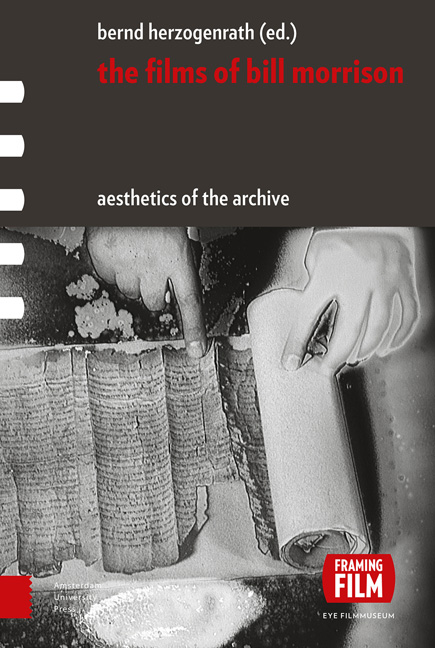Book contents
- Frontmatter
- Contents
- Acknowledgments
- Aesthetics of the Archive: An Introduction
- Chapter 1 Drafts and Fragments: Reflections around Bill Morrison and the Paper Print Collection
- Chapter 2 The Film of Her: The Cine-Poet Laureate of Orphan Films
- Chapter 3 Ghost Trip: Searching for Potential Myths
- Chapter 4 Decasia: The Matter | Image: Film is also a Thing
- Chapter 5 The Mesmerist: Illustrating the Return of the Repressed
- Chapter 6 Light is Calling: Celluloid Dreams
- Chapter 7 Gotham: Zoetrope: Block by Block
- Chapter 8 Outerborough: Early Cinema Revisited
- Chapter 9 The Highwater Trilogy: Thinking the Liquid – On the Ethics of Water and the Material Ecologies of Disaster and Ruination
- Chapter 10 Porch: Archives, Collective Memory, and the Poetics of Home Movies
- Chapter 11 The Future Lasts Long: The Romanov Lost Family Archives
- Chapter 12 Who by Water: Variations on Matter, Figures, Memory, and Mythology
- Chapter 13 Every Stop on the F-Train: Beyond and within the Restless Netherworld of (Manhattan’s) Mind
- Chapter 14 Spark of Being: Bachelor Machine
- Chapter 15 The Miners’ Hymns: Acts of Resurrection
- Chapter 16 Tributes – Pulse: A Requiem for the 20th Century: Death | Drive | Image
- Chapter 17 Just Ancient Loops: The Loops of Life in Intonation
- Chapter 18 The Great Flood: Water is Transparence Derived from the Presence of Everything
- Chapter 19 Re-Awakenings: Bill Morrison in Conversation
- Index of Film Titles
- Index of Names
- Index of Subjects
- Already Published
Chapter 18 - The Great Flood: Water is Transparence Derived from the Presence of Everything
Published online by Cambridge University Press: 12 December 2020
- Frontmatter
- Contents
- Acknowledgments
- Aesthetics of the Archive: An Introduction
- Chapter 1 Drafts and Fragments: Reflections around Bill Morrison and the Paper Print Collection
- Chapter 2 The Film of Her: The Cine-Poet Laureate of Orphan Films
- Chapter 3 Ghost Trip: Searching for Potential Myths
- Chapter 4 Decasia: The Matter | Image: Film is also a Thing
- Chapter 5 The Mesmerist: Illustrating the Return of the Repressed
- Chapter 6 Light is Calling: Celluloid Dreams
- Chapter 7 Gotham: Zoetrope: Block by Block
- Chapter 8 Outerborough: Early Cinema Revisited
- Chapter 9 The Highwater Trilogy: Thinking the Liquid – On the Ethics of Water and the Material Ecologies of Disaster and Ruination
- Chapter 10 Porch: Archives, Collective Memory, and the Poetics of Home Movies
- Chapter 11 The Future Lasts Long: The Romanov Lost Family Archives
- Chapter 12 Who by Water: Variations on Matter, Figures, Memory, and Mythology
- Chapter 13 Every Stop on the F-Train: Beyond and within the Restless Netherworld of (Manhattan’s) Mind
- Chapter 14 Spark of Being: Bachelor Machine
- Chapter 15 The Miners’ Hymns: Acts of Resurrection
- Chapter 16 Tributes – Pulse: A Requiem for the 20th Century: Death | Drive | Image
- Chapter 17 Just Ancient Loops: The Loops of Life in Intonation
- Chapter 18 The Great Flood: Water is Transparence Derived from the Presence of Everything
- Chapter 19 Re-Awakenings: Bill Morrison in Conversation
- Index of Film Titles
- Index of Names
- Index of Subjects
- Already Published
Summary
ABSTRACT
This associative essay about The Great Flood (2013) hinges on two televisual outbursts: Celine Dion, on CNN's Larry King Live, taking to task the American military-industrial complex for its refusal to intervene forcefully in the immediate aftermath of Hurricane Katrina; a black gentleman, who appears in Spike Lee's When The Levees Broke (2006), and who has been displaced from his home after Katrina – ‘I’m an American. How can I be a refugee?’ This essay interlaces three hydropolitical disasters – The Great Flood in 1927, Hurricane Katrina in 2005, and Hurricane Sandy in 2012 – to explore the limits of quantificatory approaches to extreme environmental events and to examine shared patterns of state violence against black and working-class Americans.
KEYWORDS
The Great Flood, Hurricane Katrina, Hurricane Sandy, Celine Dion
Watching the water, I am stricken with vertigo of meaning. Water is the final conjugation: an infinity of form, relation, and content. (I never know where I’m standing when I’m standing by the water).
– Roni Horn 2011I am watching The Great Flood. Its angry water, terrible panoramas, its sweep and majesty, its dark sublime: I am impaled and transfixed. But I am also taken back to terrors past, riverine disasters that, for a long time, were the stuff of dusty history books, but whose memory this film rekindles and reanimates. There was a long Great Flood in 1927. It has a backstory and tributary narratives.
‘During the nineteenth century’, Pete Daniel writes in Deep’n As It Come ‘the line of levees lengthened along the banks of the Mississippi, but no matter how high the levees grew in times of great floods the river would find a way through. People who lived along it came to measure time not simply in years, but in flood years - 1858, 1862, 1867, 1882, 1884, 1890, 1897, 1903, 1912, 1913, 1922’ (1977, 5).
Watching a film, especially in this current era, feels strangely partial and fragmented. To watch a film on or through a smartphone or laptop is to know that any thoughts, speculations, and questions it generates can be rapidly shared or even answered. Open another window, tap out a query in a search engine, flick through rivers of images, drift through data, assemble – in almost-ambient fashion – your own augmented version of that film.
- Type
- Chapter
- Information
- The Films of Bill MorrisonAesthetics of the Archive, pp. 265 - 276Publisher: Amsterdam University PressPrint publication year: 2017



